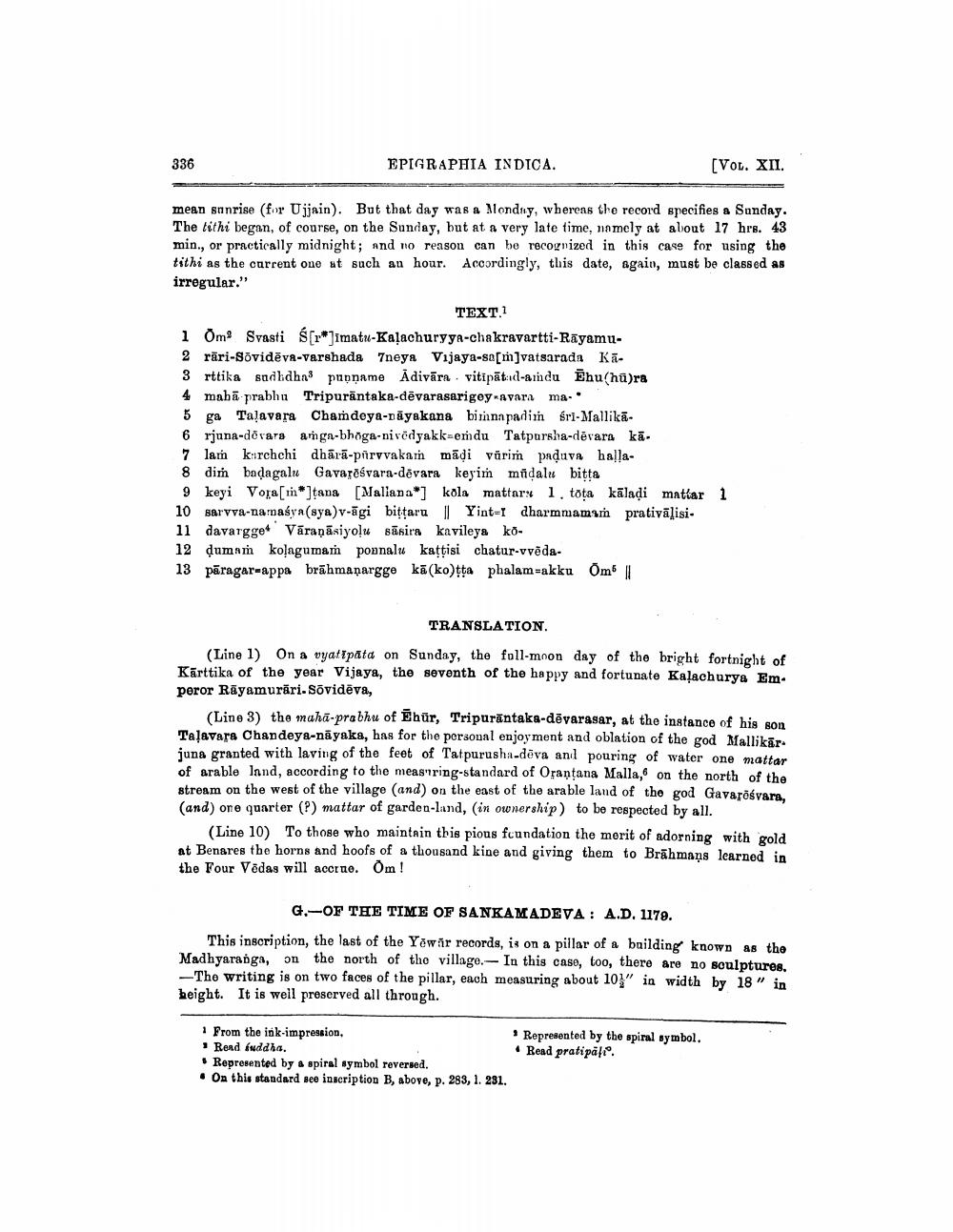________________
336
EPIGRAPHIA INDICA.
[VOL. XII.
mean sonrise (for Ujjain). But that day was a Monday, whereas the record specifies a Sunday. The lithi began, of course, on the Sunday, but at a very late time, namely at about 17 hrs. 43 min., or practically midnight; and no reason can be recognized in this case for using the tithi as the current one at such an hour. Accordingly, this date, again, must be classed as irregular."
TEXT.1 1 Om Svasti S [*Jimatu-Kaļachuryya-chakravartti-Rayamu2 räri-Sovidëva-varshada 7neya Vijaya-so[m]vatsarada Kā. 3 rttika sudhdha puppame Adivāra . vitipāt:d-andu Ehu(hūra 4 mabā prabhu Tripurantaka-dēvarasarigey-avara ma 5 ga Talavara Chamdeya-Dayakana bina padin Sri-Mallika. 6 rjuna-dovas amga-bhoga-nivēdyakk-endu Tatpursha-dēvara kā. 7 lam kurchchi dhārā-parvvakar mādi vārim paduva halla8 diñ badagalu Gavarośvara-dēvara keyim midalu bitta 9 keyi Vora[ın"]tana [Maliana"] kola mattars 1. tota kāladi matlar 10 sarvva-namasya (sya)v-āgi bittaru | Yint-T dharmmamın prativālisi. 11 davargget Vāraṇāsiyolu sāsira kavileya ko12 dumnm kolaguman ponnal kattisi chatur-vvoda13 pāragar-appa brāhmaṇargge kā (ko)tta phalam-akku Oml
1
TRANSLATION
(Line 1) On a vyattpata on Sunday, the foll-moon day of the bright fortnight of Kárttika of the year Vijaya, the seventh of the happy and fortunate Kalachurya Em. peror Rāyamurări.Sõvidēva,
(Line 3) the mahā-prabhu of Ehūr, Tripurāntaka-dēvarasar, at the instance of his son Talavara Chandeya-näyaka, has for the personal enjoyment and oblation of the god Mallikār. juna granted with laving of the feet of Tatpurusha-döva anil pouring of water one mattar of arable Innd, according to the measuring-standard of Orantana Malla, on the north of the stream on the west of the village (and) on the east of the arable land of the god Gavarośvara, (and) one quarter (?) mattar of garden-land, (in ownership) to be respected by all.
(Line 10) To those who maintain this pious foundation the merit of adorning with gold at Benares the horns and hoofs of a thousand kine and giving them to Brāhmaṇs learned in the Four Vēdas will accrue. Om !
G.-OF THE TIME OF SANKAM ADEVA: A.D. 1179. This inscription, the last of the Yēwir records, is on a pillar of a building known as the Madhyaranga, on the north of the village. In this case, too, there are no soulptures.
-The writing is on two faces of the pillar, each measuring about 10" in width by 18" in height. It is well preserved all through.
1 From the ink-impression,
Read iuddha. * Represented by a spiral symbol reversed. • On this standard see inscription B, above, p. 283, 1. 231.
Represented by the spiral symbol. • Read pratipasi




